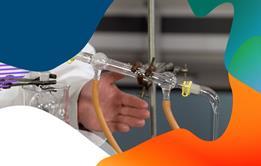Provide a context in which learners can plan a sequence of tests – the less the better! – to identify a set of unlabelled organic compounds
Qualitative tests of organic functional groups appear in all 16–18 courses. It is not enough to just be able to recall how to carry out each test. This experiment requires a solid understanding of the tests and a logical approach to deduce the identities through positive/negative results and a process of elimination.
Chapter titles: 00:10 Introduction to the investigation; 02:04 Test for carboxylic acid by adding a few drops of sodium hydrogen carbonate solution to each sample; 03:35 Test for an unsaturated hydrocarbon by adding 1 cm3 of bromine water to each sample; 05:26 Test for haloalkanes with ethanol and silver nitrate solution; 07:40 Test for alcohols with acidified potassium dichromate solution, microscale; 09:49 Test for carbonyl groups with Brady’s reagent (a solution of dinitrophenylhydrazine (2,4-DNPH)), microscale; 12:07 Test for aldehydes using Tollens’ reagent.
Teacher notes
Full teacher notes are available in the supporting resources booklet, including ideas for how to use this video and the supporting resources as part of your teaching.
Technician notes including the equipment list and safety notes are provided . If you are planning to carry out the practical in the classroom, you will need to carry out your own risk assessment.
Qualitative tests of organic functional groups appear in all 16–18 courses. Not all tests will be on all specifications, but this video aims to covers quite a comprehensive list. When running the experiment, a reduced or adapted list of samples, relevant to your own course, may be more suitable. The six samples in this investigation include the following organic functional groups:
- alkene
- aldehyde
- ketone
- alcohol
- carboxylic acid
- haloalkane
Prior knowledge
In order for learners to correctly analyse and identify the components of an unknown molecule/mixture they need to have a good working knowledge and understanding of the different functional groups that could be present. They should be able to:
- Identify aldehydes, ketones, alcohols, carboxylic acids, alkenes and haloalkanes.
- Name and draw different organic compounds that include the complete range of functional groups and 1⁰, 2⁰ and 3⁰ alcohols.
They should be able to describe:
- The oxidation of alcohols and aldehydes using acidified potassium dichromate and understand that there is no oxidation reaction with 3⁰ alcohols and ketones.
- Nucleophilic substitution and the hydrolysis of haloalkanes.
- Electrophilic addition of alkenes.
- Halide tests in inorganic chemistry.
- Neutralisation reactions with metal carbonate.
Common misconceptions
Be aware of misconceptions learners may have around this practical, for example:
- Learners often think molecules only contain one functional group and don’t appreciate that in fact many organic molecules contain more than one functional group. To overcome this belief, learners should be exposed to compounds that have more than one functional group. This will help them to understand that these tests characterise part of a molecule. In other words, they should be shown that a single compound can be positive for two different tests, indicating the presence of two functional groups.
- Many learners think that the best way to identify an unknown functional group is through trial and error. If you do all the tests, then eventually there will be a positive result. However, a better way is to take an investigative approach and start off by making a chemical test chart; in which the result of one test will help inform the next test you do. This systematic approach could save a lot of time in the long run.
- Learners often think that they can get away with just learning the test and positive result for each different functional group. Unless they can apply this knowledge and work their way through a problem they are not taking the useful learning from this practical, and will struggle to link this practical work to the theory they are leaning. This will not help them when it comes to answering the exam questions. As seen from the list of prior knowledge, there are many links to theory from various areas of chemistry.
Further practical activities and other resources
There is overlap with chemical tests for inorganic compounds in this experiment, with the identification of haloalkane and metal halide precipitates, Inorganic chemical tests provides suggestions for practical activities and links.
Also check out…
- Organic chemistry: a practical opportunity – this CPD article explores some of the challenges students face when they first encounter organic chemistry.
- Link to careers with this job profile of a Consumer products technician.
- Identifying ions, our practical video with supporting resources for 14–16 learners, could be used for revision prior to this practical.
Downloads
Qualitative tests for organic functional groups: supporting resources
Handout | PDF, Size 0.65 mbQualitative tests for organic functional groups: supporting resources
Editable handout | Word, Size 0.79 mbQualitative tests: technician notes
Handout | PDF, Size 1.81 mbQualitative tests for organic: learner notes
Experiment | PDF, Size 0.12 mbQualitative tests for organic: learner notes
Experiment | Word, Size 0.12 mbQualitative tests for organic functional groups: integrated instructions
Experiment | PDF, Size 0.15 mbQualitative tests for organic functional groups: integrated instructions
Experiment | PowerPoint, Size 91.78 kb
Additional information
The original video script and supporting resources were written by Dorothy Warren. The integrated instructions were produced by David Paterson and the technician notes were written by Sandrine Bouchelkia.
Practical videos | 16–18 years

Videos of key practical techniques and apparatus for revision, flipped learning or remote teaching
- 1
- 2
- 3
- 4
 Currently
reading
Currently
reading
Qualitative tests for organic functional groups
- 6
- 7
- 8
- 9
- 10
- 11
- 12
- 13











































No comments yet